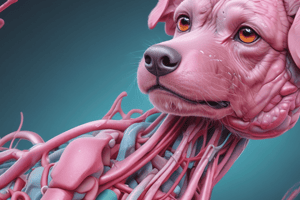Podcast
Questions and Answers
¿Cuál de las siguientes es una causa no infecciosa de la FLUTD en gatos?
¿Cuál de las siguientes es una causa no infecciosa de la FLUTD en gatos?
- Virus del herpes felino
- Urolitos (correct)
- Cistitis bacteriana
- Escherichia coli
¿Cuál de los siguientes factores de riesgo está asociado principalmente con la FLUTD?
¿Cuál de los siguientes factores de riesgo está asociado principalmente con la FLUTD?
- Alto consumo de agua
- Machos de 1-10 años (correct)
- Vida al aire libre
- Dieta rica en proteínas
¿Qué signo clínico es característico de la cistitis idiopática felina?
¿Qué signo clínico es característico de la cistitis idiopática felina?
- Micciones frecuentes (correct)
- Estranguria
- Poliaquiuria
- Obstrucción uretral
Cuál de las siguientes es una opción de tratamiento para una infección del tracto urinario (ITU)?
Cuál de las siguientes es una opción de tratamiento para una infección del tracto urinario (ITU)?
¿Qué microorganismo es el más comúnmente asociado con las infecciones del tracto urinario en gatos?
¿Qué microorganismo es el más comúnmente asociado con las infecciones del tracto urinario en gatos?
¿Cuál es la característica principal de la injuria renal aguda?
¿Cuál es la característica principal de la injuria renal aguda?
¿Qué síntoma es común en la enfermedad renal crónica?
¿Qué síntoma es común en la enfermedad renal crónica?
¿Cuál de las siguientes es una causa prerrenal de la injuria renal aguda?
¿Cuál de las siguientes es una causa prerrenal de la injuria renal aguda?
¿Qué término se refiere a la presencia de pus en la orina?
¿Qué término se refiere a la presencia de pus en la orina?
¿Cuál de estas afirmaciones es verdadera sobre la oliguria?
¿Cuál de estas afirmaciones es verdadera sobre la oliguria?
¿Qué procedimiento implica la extracción de un cálculo del sistema urinario?
¿Qué procedimiento implica la extracción de un cálculo del sistema urinario?
¿Cuál es una de las principales causas comunes de enfermedad renal crónica?
¿Cuál es una de las principales causas comunes de enfermedad renal crónica?
¿Qué método se utiliza para diagnosticar la injuria renal aguda?
¿Qué método se utiliza para diagnosticar la injuria renal aguda?
¿Cuál es el objetivo de la clasificación IRIS para la enfermedad renal crónica (ERC)?
¿Cuál es el objetivo de la clasificación IRIS para la enfermedad renal crónica (ERC)?
¿Qué característica distingue a la pielonefritis ascendente de la descendente?
¿Qué característica distingue a la pielonefritis ascendente de la descendente?
¿Cuál no es un signo clínico típico de la urolitiasis?
¿Cuál no es un signo clínico típico de la urolitiasis?
¿Cuál de las siguientes opciones representa un tratamiento adecuado para la fase crónica de la enfermedad renal?
¿Cuál de las siguientes opciones representa un tratamiento adecuado para la fase crónica de la enfermedad renal?
¿Qué tipo de cálculos urinarios es común en los dálmatas?
¿Qué tipo de cálculos urinarios es común en los dálmatas?
¿Cuál es la causa de las glomerulopatías en gatos?
¿Cuál es la causa de las glomerulopatías en gatos?
¿Cuál de las siguientes opciones describe mejor el tratamiento inicial para la pielonefritis?
¿Cuál de las siguientes opciones describe mejor el tratamiento inicial para la pielonefritis?
¿Qué prueba se considera el 'gold standard' para el diagnóstico de pielonefritis?
¿Qué prueba se considera el 'gold standard' para el diagnóstico de pielonefritis?
Flashcards
Hematuria
Hematuria
Presence of blood in the urine.
Anuria
Anuria
Absence of urine production.
Oliguria
Oliguria
Reduced urine volume (< 0.5 ml/kg/hour).
Renal Injury (Acute)
Renal Injury (Acute)
Signup and view all the flashcards
Renal Injury (Chronic)
Renal Injury (Chronic)
Signup and view all the flashcards
Azotemia
Azotemia
Signup and view all the flashcards
Prerrenal Injury
Prerrenal Injury
Signup and view all the flashcards
Postrenal Injury
Postrenal Injury
Signup and view all the flashcards
Acute Kidney Disease Treatment
Acute Kidney Disease Treatment
Signup and view all the flashcards
Chronic Kidney Disease (CKD)
Chronic Kidney Disease (CKD)
Signup and view all the flashcards
IRIS Classification for CKD
IRIS Classification for CKD
Signup and view all the flashcards
Pyelonephritis
Pyelonephritis
Signup and view all the flashcards
Urolithiasis
Urolithiasis
Signup and view all the flashcards
Glomerulopathies
Glomerulopathies
Signup and view all the flashcards
Urolithiasis Diagnosis
Urolithiasis Diagnosis
Signup and view all the flashcards
Pyelonephritis Treatment
Pyelonephritis Treatment
Signup and view all the flashcards
FLUTD in Cats
FLUTD in Cats
Signup and view all the flashcards
FLUTD Causes (Non-Infectious)
FLUTD Causes (Non-Infectious)
Signup and view all the flashcards
Feline Idiopathic Cystitis
Feline Idiopathic Cystitis
Signup and view all the flashcards
UTI in Cats
UTI in Cats
Signup and view all the flashcards
UTI Signs (Lower vs Higher)
UTI Signs (Lower vs Higher)
Signup and view all the flashcards
Study Notes
Sistema Genitourinario en Animales Menores
- Hematuria: Presence of blood in the urine. Persistent or intense hematuria requires investigation.
- Anuria: Absence of urine output.
- Oliguria: Reduced urine volume, less than 0.5 ml/kg/hour.
- Polaquiuria: Increased frequency of urination.
- Poliuria: Excessive urine volume.
- Piuria: Presence of pus in the urine.
- Proteinuria: Presence of proteins in the urine.
- Estranguria: Urination in small amounts.
- Azotemia: Elevated urea and creatinine in the blood, due to kidney failure. This involves increased concentration of non-protein nitrogenous substances.
- Litogénico: Capable of forming or producing calculi (stones).
- Litolisis: Dissolution of calculi.
- Litotomía: Removal of a calculus from the urinary system (from urethra, ureter, pelvis, or kidney).
- Cistectomía: Partial or complete removal of the bladder.
- Cistotomía: Opening of the bladder.
Enfermedades Renales
-
Injury Renal Acute (IRA): Sudden and reversible loss of kidney function.
-
Etiology (Causes):
- Prerrenal: Reduced blood flow to the kidneys (e.g., heart failure, bleeding).
- Renal: Problems within the kidney tissue (e.g., inflammation, infections).
- Postrenal: Obstruction of urine outflow (e.g., stones, tumors).
-
Clinical Signs (Symptoms): Loss of appetite, dehydration, vomiting, abdominal pain.
-
Diagnosis:
- Physical exam
- Blood chemistry
- Urinalysis
- Ultrasound
-
Treatment: Identifying and treating the underlying cause, fluid replacement, and correcting electrolyte imbalances.
-
Chronic Kidney Disease (CKD): Progressive and slow loss of kidney function over at least three months.
-
Common Causes: Old age, genetic predisposition, exposure to toxins.
-
Clinical Signs (Symptoms): Weight loss, increased urination, increased thirst, loss of appetite.
-
Diagnosis:
- History
- Physical Exam
- Complete blood count (CBC)
- Serum Biochemistry Profile (including blood urea nitrogen (BUN) and creatinine)
- Urinalysis
- Ultrasound
-
Treatment: Slowing disease progression, fluid therapy, pain relief, and regulating phosphate and potassium levels.
Other Specific Renal and Urinary Tract Conditions
-
Pyelonephritis: Inflammation and infection of the renal pelvis and surrounding tissues. Usually follows a lower urinary tract infection, with systemic(general) illness.
-
Urolithiasis: Formation of stones in the urinary tract (urethra, bladder). Cause by metabolic conditions, leading to crystal formation. Possible pain, frequent urination, blood in the urine.
-
Glomerulopathies: Diseases affecting the glomeruli (filtering units) of the kidneys. Causes varied, including infections or immune system disorders. Clinical signs often involve protein in the urine and sometimes a nephrotic syndrome.
-
Feline Idiopathic Cystitis: Chronic bladder inflammation in cats, without an identifiable cause. A likely cause of the inflammation is stress. Often, the only treatment is lifestyle changes and possibly medical intervention.
Studying That Suits You
Use AI to generate personalized quizzes and flashcards to suit your learning preferences.





